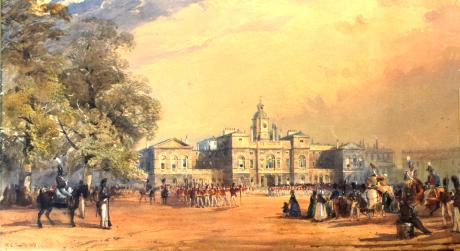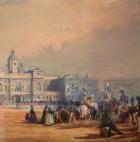"W C Smith 1851"
The Museum Galleries, 38 Piccadilly
Trooping the Colour is a ceremony performed by regiments of the British and Commonwealth armies. It has been a tradition of British infantry regiments since the 17th century, although the roots go back much earlier. On battlefields, a regiment's colours, or flags, were used as rallying points. Consequently, regiments would have their ensigns slowly march with their colours between the soldiers' ranks to enable soldiers to recognise their regiments' colours. Since 1748 Trooping the Colour has also marked the official birthday of the British sovereign. It is held in London annually on a Saturday in June on Horse Guards Parade by St. James's Park, and coincides with the publication of the Birthday Honours List. Among the audience are the Royal Family, invited guests, ticketholders and the general public. The colourful ceremony, also known as "The Queen's Birthday Parade", is broadcast live by the BBC within the UK and is telecast also in Germany and Belgium.
The Queen travels down The Mall from Buckingham Palace in a royal procession with a sovereign's escort of Household Cavalry (mounted troops or horse guards). After receiving a royal salute, she inspects her troops of the Household Division, both foot guards and horse guards, and the King's Troop, Royal Horse Artillery. Each year, one of the foot-guards regiments is selected to troop its colour through the ranks of guards. Then the entire Household Division assembly conducts a march past the Queen, who receives a salute from the saluting base. Parading with its guns, the King's Troop takes precedence as the mounted troops perform a walk-march and trot-past.
The music is provided by the massed bands of the foot guards and the mounted bands of the Household Cavalry, together with a Corps of Drums, and occasionally pipers, totalling approximately 400 musicians.
Returning to Buckingham Palace, the Queen watches a further march-past from outside the gates. Following a 41-gun salute by the King's Troop in Green Park, she leads the Royal Family on to the palace balcony for a Royal Air Force flypast. A regiment's colours embody its spirit and service, as well as its fallen soldiers. The loss of a colour, or the capture of an enemy colour, were respectively considered the greatest shame, or the greatest glory on a battlefield. Consequently, regimental colours are venerated by officers and soldiers of all ranks, second only to the sovereign. Only battalions of infantry regiments of the line carry colours; the Royal Artillery's colours, for example, are its guns. Rifle regiments did not form a line and thus never carried colours. Their battle honours are carried on their drums. The exception to this is the Honourable Artillery Company, which has both a stand of colours and guns. Trooping the Colour is an old ceremony whereby a battalion would fall in by companies and the colour-party would "troop" or march the colours through the ranks so that every man would see that the colours were intact. This was done before and after every battle. This ceremony has been retained through time and is today largely ceremonial.
In the United Kingdom, Trooping the Colour is also known as the Queen's Birthday Parade. It has marked the official birthday of the sovereign since 1748, and has occurred annually since 1820 (except in bad weather, periods of mourning and other exceptional circumstances).The first Trooping of the Colour took place on Horse Guards Parade on 4 June 1805. From the reign of King Edward VII, the sovereign has taken the salute in person. It was Edward VII who moved Trooping the Colour to its June date, because of the vagaries of British weather (his own natural birthday being in November).
Trooping the Colour allows the troops of the Household Division to pay a personal tribute to the sovereign with great pomp and pageantry. Crowds lining the route and in St. James's Park listen to music performed by both massed and mounted bands.
The Queen has attended Trooping the Colour in every year of her reign except when prevented by a rail strike in 1955. Formerly mounted herself, she commenced riding in a carriage in 1987.
William Collingwood Smith (10 December 1815 Greenwich - 15 March 1887 Brixton Hill),was a noted English watercolourist.
William's father William Smith worked for the Admiralty and was a musician and amateur artist. William had no formal training in art, but had studied under James Duffield Harding. Initially he painted in oils, but later became a proficient watercolourist. In 1843 he became an Associate, and subsequently a Member, of the Society of Painters in Water Colours which later became the Royal Watercolour Society, serving as treasurer for some twenty years, and starting its Art Club. He also joined the New Society of Painters in Water Colours.
Specialising in marine and river scenes, and sweeping landscapes, he turned out more than a thousand paintings and drawings. He travelled extensively in Britain and on the Continent, often painting scenes which had news interest. His images were often engraved and reproduced in the Illustrated London News. Shipping scenes he painted included HMS Dreadnought, which took part in the Battle of Trafalgar. His first exhibition at the Royal Academy was in 1836 and his last in 1855, also exhibiting with the Water Colour Society and at the Suffolk Street Galleries.
He enjoyed an outstanding reputation as a teacher so that his classes at Wyndham Lodge, 13 Brixton Hill, included not only amateurs, but also professionals, and military and naval officers. His works are to be found in numerous galleries, both public and private.
His grave is in the West Norwood Cemetery. He is buried there alongside his wife Louisa Triquet and his son William Harding Collingwood Smith who was also an artist.



